The RCA Photophone Type PB-31
The Radio City Music Hall Microphone
 Also on this page are the Type 4PB31A1 ribbon mic, the Type 4PA72A1 amplifier, the Type PB-140 velocity mic (MI-4003), the Type PB-144 velocity mic, the Type 44-A velocity mic, and the Type 44-B velocity mic. Also on this page are the Type 4PB31A1 ribbon mic, the Type 4PA72A1 amplifier, the Type PB-140 velocity mic (MI-4003), the Type PB-144 velocity mic, the Type 44-A velocity mic, and the Type 44-B velocity mic.
Of major historical significance, this is the first ribbon microphone, which was created in 1931. It was a breakthrough technology in sound, and revolutionized the recording and broadcast industry, setting a new standard in frequency response. The clarity and realism were unmatched by any of the condenser microphones of its day.

The Photophone PB-31 had a limited production. It is estimated that only fifty were made, being replaced by the 44-A just a few months later, in 1932. (Images of a 44-A can be seen below.) The succession of RCA ribbon and magnet velocity microphones was rooted in the elegant, machine-age design of the Photophone PB-31.
When New York’s Radio City Music Hall opened in 1932, it had been outfitted with a state-of-the-art sound system, including no less than forty Photophone PB-31 microphones. The mics were strategically installed in the footlights and proscenium.
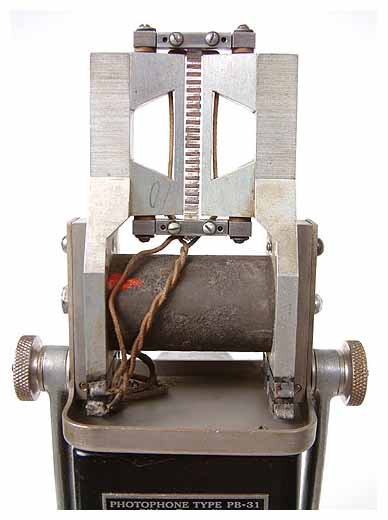
For more than fifty years the mics were operational. In the 1980s, when a new sound system was installed, the old equipment was discarded.
The few Photophone PB-31s that survive today originate from Radio City, as does this one. This microphone is one of six still known to exist.
For those unfamiliar with the Photophone PB-31 sound characteristic, it could be best described as flat and dark, similar to the sonics and gain level of the 44-A.
This mic has excellent high frequencies, and most people are startled to hear a seventy-year old microphone sound so modern.
The finish is matte-nickel. The rear P-plug terminates with a standard XLR connector. Measurements are 11 inches long and 4.75 inches wide. Weight is five pounds.

No Master Index number was assigned the Photophone PB-31.
Type 4PB31A1 Ribbon Microphone,
and Type 4PA72A1 Mic Amplifier.
This PB-31A is unique in that the amplifier was connected via a cable with two matching transformers so the mic could be placed at some distance from the preamp. The preamps were kept in an area called a jug room. It is believed that no more than ten of these were made. This is a highly unusual example depicting very early microphone history. Documents found with this unit are dated January 25 through January 28 of 1932. This item was found in Australia after being held in storage for forty years. It was caught in a warehouse fire and severly damaged. It was then transferred to an audio dealer who decided to sell it. After being sold, both pieces were completly restored to their original condition by Silvia Classics.









The Type 4PB31A1 Ribbon Microphone and Type 4PA72A1 Microphone Amplifier descriptive text and photographs seen above were provided via the kindness of Jerry Silvia of Silvia Classics. These images are here with the permission of Mr. Silvia, who died in 2013. Jerry, you are missed.
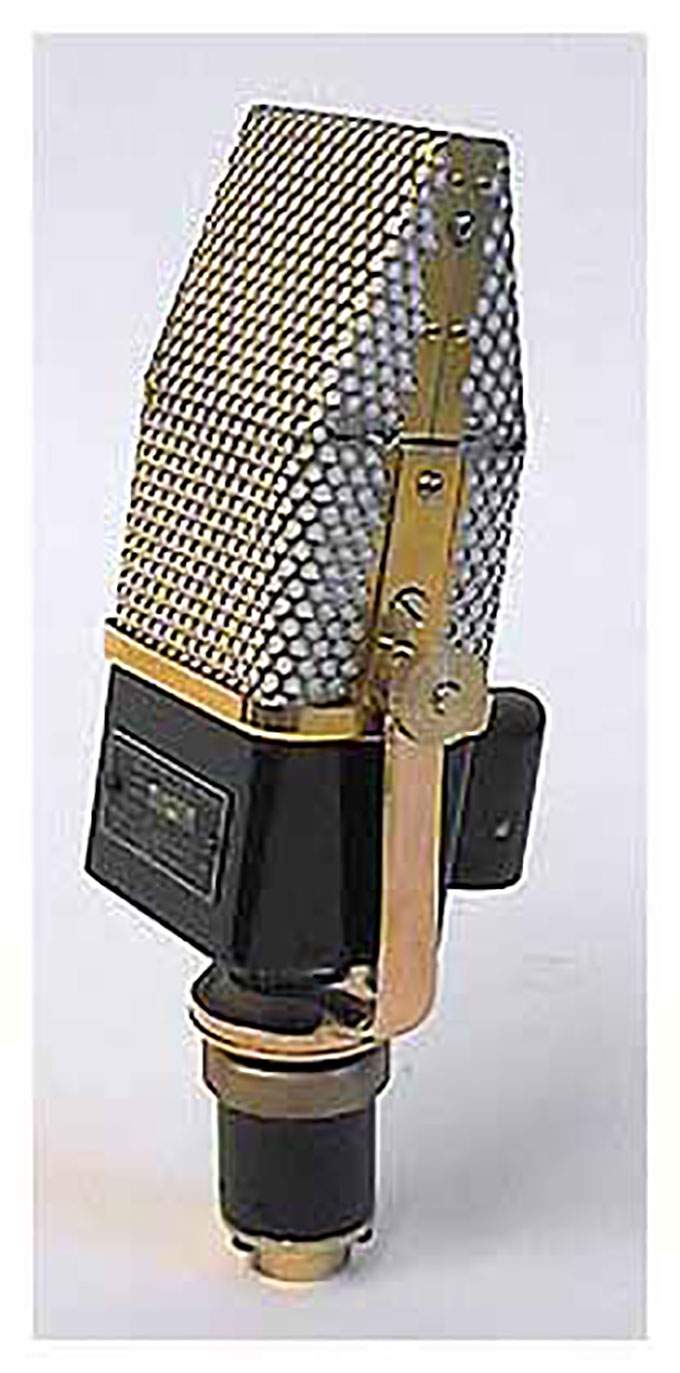
Here is another Photophone PB-31, this one with a brass finish.
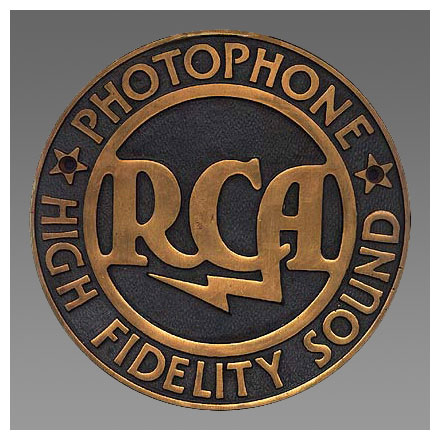
“These plaques are bronze castings displayed in theaters equipped with RCA Photophone sound equipment in the mid 1930s. They are about eight inches in diameter. RCA and Western Electric were in fierce competition for theater sound business, and whenever a system was installed or, more importantly, when the competitor’s system was replaced, one of these plaques was installed in the lobby or on an outside wall where they could not be missed by the patrons. Of course Western Electric had similar plaques.” —Mike Schultz
The RCA Type PB-140 Velocity Mic,
MI-4003

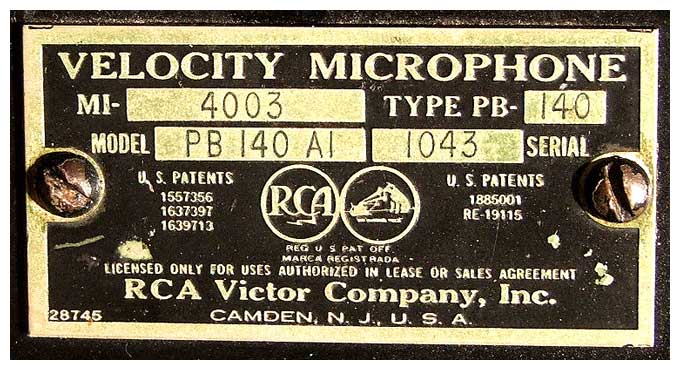
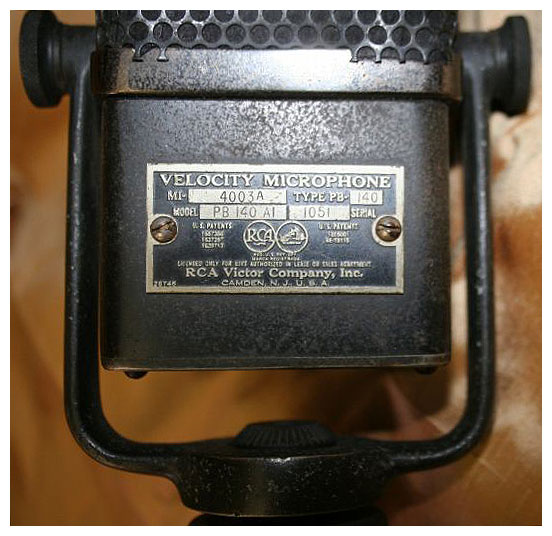

RCA Type PB-144 Velocity Mic
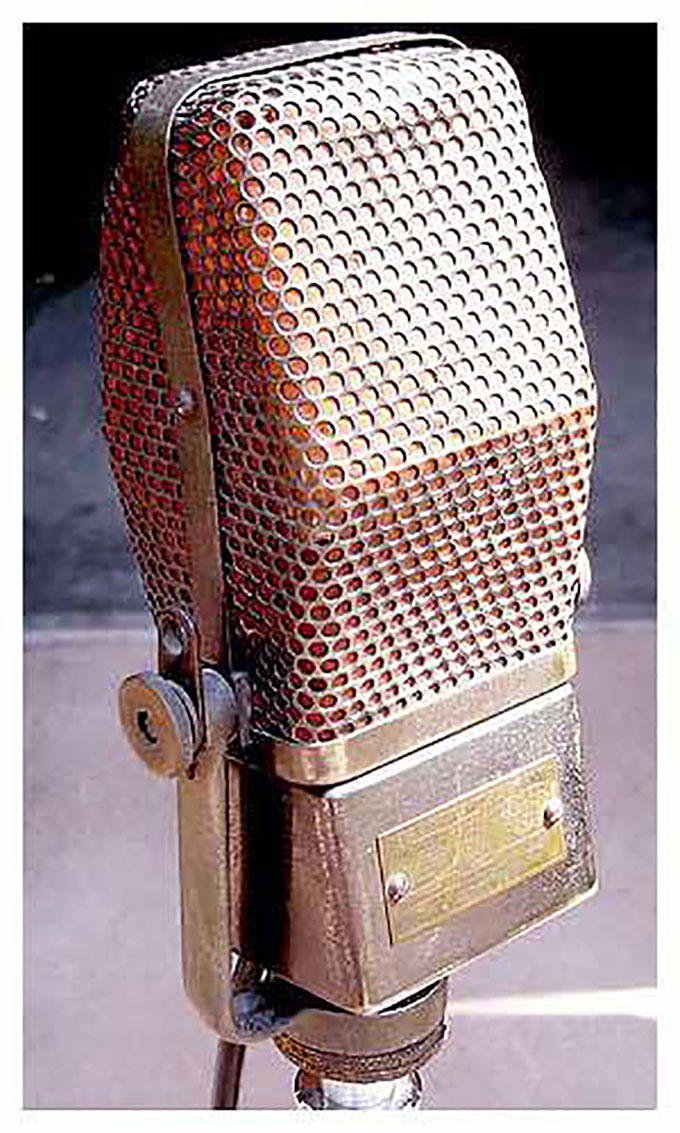
RCA also manufactured a Photophone Type PB-144, MI-3015 and MI-3027 in 1936. Our thanks go to Mr. Howard Rieder for his kindness and courtesy in providing this commentary on his life’s work and these photographs specifically for this page.
When I worked at KUSC, I wrote, produced, and programmed the Saturday morning and afternoon, and announced. It was a heady period of time and we did some crazy things. Stan Chambers at KTLA was one of the early staff announcers, a returned GI. Stan went on to the only other job he ever had—at KTLA. At that time, the radio-television department was separate from the Cinema Department. It was housed in the Hancock Building while the Cinema Department had its own building three blocks away.
We had three broadcast studios: Studio A, a 450-seat audience studio otherwise known as the Hancock Auditorium; Studio B, an announce studio equipped with turntables, and a news studio located in the area above the auditorium next to the projection booth. On the other side of the projection room was located the master control with Magnecord tape machines and the 1000-watt transmitter (effective radiated power—3500 watts). Our engineers all had first-class FCC licenses, did no announcing, logged the meter readings of the transmitter and engineered for the shows that were done in Studio A and Studio C. Announcers ran the board in Studio B and spun the records.
Studio C was in another part of the building and was a fairly large flat studio designed for small music and dramatic programming. Studios A and C had excellent pianos. C was equipped with sound effects equipment for use on the dramatic shows. The control room was equipped with turntables and initially two lathes for cutting 16-inch transcriptions. Later, a Magnecord tape machine was installed. We often used it as an announce booth if something went awry in Studio B.
The antenna was erected on the roof of the building and since there was not much air competition at that time, we could be heard from Santa Barbara to San Diego… if anyone had FM receivers, which were few and far between. KUSC was the first FM station west of the Mississippi. What many people don’t know is that the station was not actually licensed to USC, but to the Hancock Foundation and the Foundation paid the managers for each day to keep the logs and the programming on the air. All of our equipment was Western Electric (boards, 639 mikes, etc.), not an RCA in the bunch. The rumor was that the chief engineer had a dispute with RCA when the studios were installed and we never saw one stick of RCA equipment. Most of us would have killed for a 44-BX. We really did not like the 639s or the other WE mikes like the “Saltshaker.”
I donated tapes and scripts of the shows I did during that time to the archives of the USC library. They apparently have little from the early era. The following will give you an idea of what I did programming on Saturday mornings and afternoons primarily, although I hasten to add that the nighttime and daytime the rest of the week was devoted to classical music, news, dramatic programs, some USC sports and some remotes from around the campus where we had a land line like Bovard Auditorium for major concerts.
With the donation, I sent along the following log of scripts and some notes which provide an additional picture of a bunch of energetic broadcasters.
List of original scripts from broadcasts
11/19/49 “IT’S US AGAIN” / “MORE ABOUT HARRIS” #1-17, #1-38.
Began as a 15-minute show, then an hour show through July 1951. Aired at 3 p.m., then 1:30 p.m., then 5 p.m. Comedy-Variety show aired live the first season and then pre-taped and live the second season.
2/29/49 “FROM ONE NOTE TO ANOTHER” # 1-19
Ran as a fifteen-minute show, twenty-five minute, and thirty-minute show. first show was taped 1/4/49 and aired 2/29/49 from 3:45-4 p.m. On 3/19/49 it aired from 5:05-5:30 p.m., then from 4/2/49, it aired from 2:05-2:30 p.m. (because of USC sports games broadcasts), from 4/9/49 it aired from 2-2:30 p.m., from 4/30/49 at 2-2:25 p.m., from 5/21/49 at 4:30-5 p.m. through 6/11/49. Shows were aired both live and taped during the season. Due to an antenna problem, the station was off the air for two weeks. During this period we taped two shows for later broadcast.
9/24/49 “MELODY AND THE LADY” #1-32
Ran as both a twenty-five and thirty-minute show. Combined comedy, drama sketches, and commercial records into a kind of musical comedy. Program ran from 9/24/49 to 11/25/50 (with some breaks for the female emcee’s illness). Show was redressed for two thirty-minute shows as “MEMORIES AND MUSIC” broadcast on 2/17/51 and 3/10/51.
4/6/49 “UNESCO WORLD REVIEW” #1-9
Ran as a fifteen-minute show from 4/6/49 through 5/30/49. Documentaries on UNESCO activities.
2/5/49 “JOE flYNN SHOW”
Ran as a thirty-minute weekly show, spun off from a show called “Concert For five.” This show was taped 2/3/49. Joe flynn, the comedian, went on to star in a number of Disney films. Show consisted of comedy sketches and an ad lib interview by flynn with a music industry personality.
8/19/49 “TROJAN LYCEUM WORKSHOP”
Half-hour dramatic show. “finale,” an original radio play written by Harry Duff, was taped 8/18/49.
Unknown “GREAT STAGE”
Documentary on Marriage, produced for exchange to other National Association of Educational Broadcasters stations.
9/25/48 “LITTLE WAX DOLL HOUSE” / “JUNIOR PLAYROOM”
Show ran through 10/16/48 on Saturdays from 5:05-5:30 p.m., renamed “Junior Playroom” which ran on Thursdays for fifteen minutes from 5:30-5:45 p.m. and on Saturdays from 5:30-5:55 p.m. through 12/14/48.
We didn’t waste much, so on the backs of some of the scripts above are station announcements and program schedules from 1948, one of which notes Stan Chambers of KTLA fame announcing KUSC programs.
KUSC broadcast at night only for its first couple of years airing classical music and live concerts from Bovard and Hancock Auditorium (which we referred to as Studio A. Studio B, FYI was upstairs from the lobby of the auditorium across the projection room from the transmitter and was the announce booth and news studio. The United Press Teletype shared the area with the toilet behind the projection room.)
Before I joined in 1948, the station went on the air on Saturdays in the morning and afternoons. I became program director for Saturday morning and afternoon from 9 to 6 for four years through 1952. I was also an announcer and disk jockey and kept the station logs. I was employed by the Hancock Foundation, which owned the station license. I don’t remember when, but the station went on the air weekdays during this period.
While I was in the Army (1952-1954), the Foundation established a TV station on UHF Channel 28 (KTHE). It broadcast primarily during the evenings. The main studio was on the first floor adjacent to the Hancock rooms, and they were used for concerts. The studio was used for other broadcasts as well. Master control was secreted in the rotunda area just outside of the Hancock rooms. The radio studio (Studio “C”) was converted, equipped with two RCA cameras, and used for student projects. Two DuMont cameras were used in the downstairs broadcast studio.
br>The original premise was that other schools (UCLA, LAUSD, etc.) would provide monetary support to the project and the Foundation would provide the impetus to get it going. This was not forthcoming. The Foundation paid for the full cost of the operation, including hiring professional directors and staff. When it was apparent that this was a financial drain, they turned the license for Channel 28 over to the University, which ran it with some student help for a short period. When it was apparent that the costs were too great, the University turned the license back to the FCC. Ten years later, KCET was established on Channel 28.
This all may be more than you really want to know, but I just got started and the historical part of all this interests me. I got a BA in Radio-Television and an MA in Cinema from USC. I went on to a 45-year career in advertising and public relations, happily using my broadcast and film background in my jobs. I was Director of Advertising, Sales Promotion and Public Relations for two companies: Thomas Organ Co. (musical instruments) and Revell Toys, finishing off the last 15 years as one of the advertising managers for Nissan Motor Corp. in USA.
As a kid growing up in L.A. radio, I acted on the “Uncle Whoa Bill Show” on KFAC (Wilshire and Mariposa, fifth floor), “Tuesday At Ten” on KXLA (Huntington Hotel, Pasadena) where we were followed by “That Hawthorne Thing,” and later was a staff relief announcer at KGER in the Beverly Hills Studio (Olympic and Robertson).
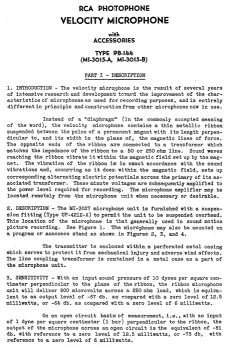
Download the manual for this mic.
fifteen pages, low rez pdf, 1.6 megabyte.
The RCA Type 44-A Velocity Mic
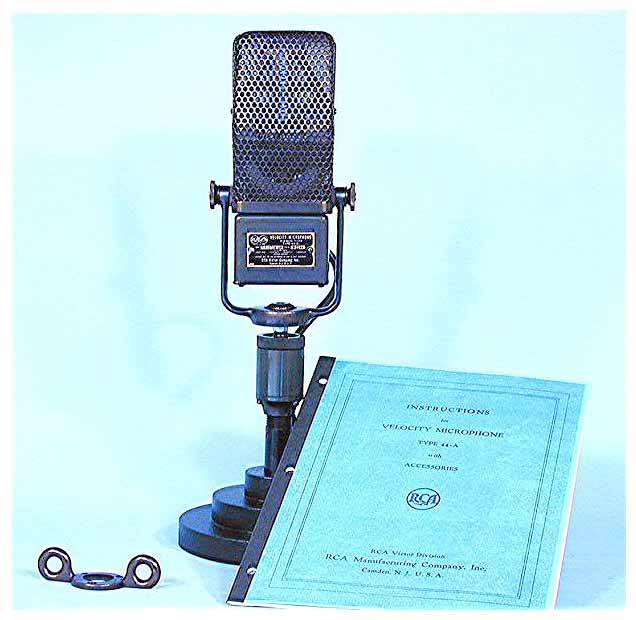

This microphone is the successor to the PB-90.
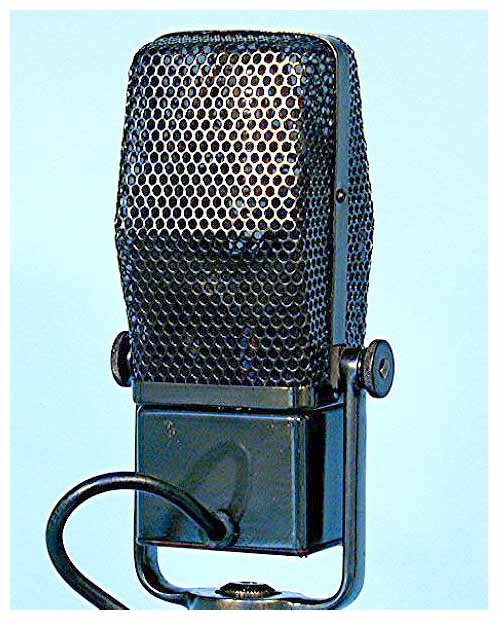
The Type 44-A was manufactured in 1932, and
has a frequency response of 30 to 16,000 Hertz.
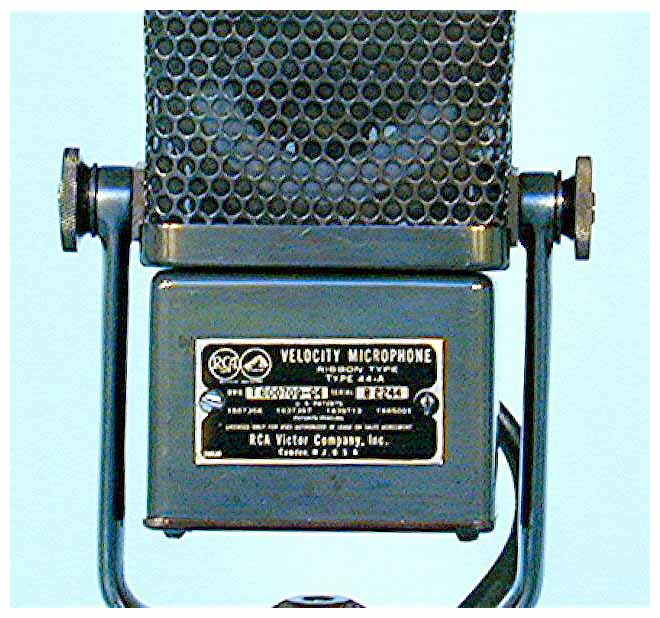
The 44-A is larger (4.5 x 3.5 x 12 inches, nine pounds)
than the PB-90 (3.5 x 3.5 x 8.5 inches, eight pounds).

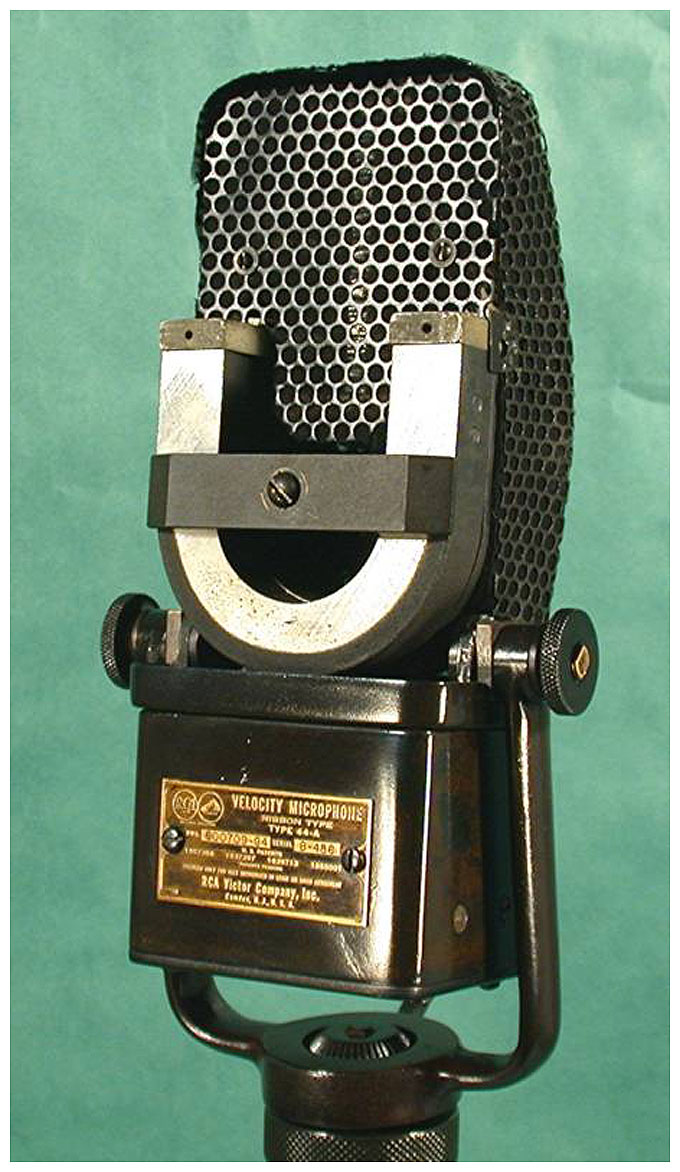



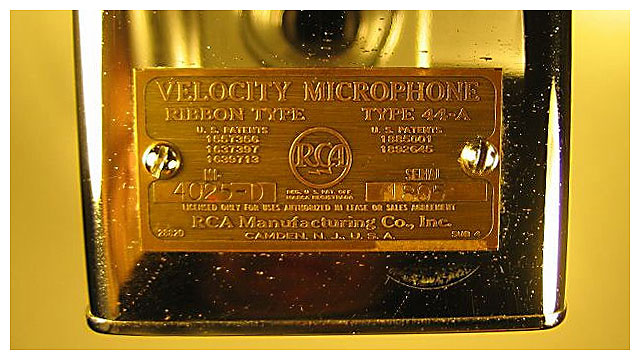
Other Type 44-A plates.
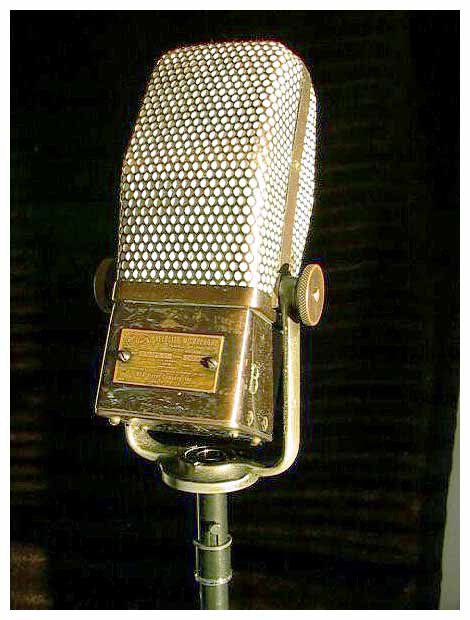


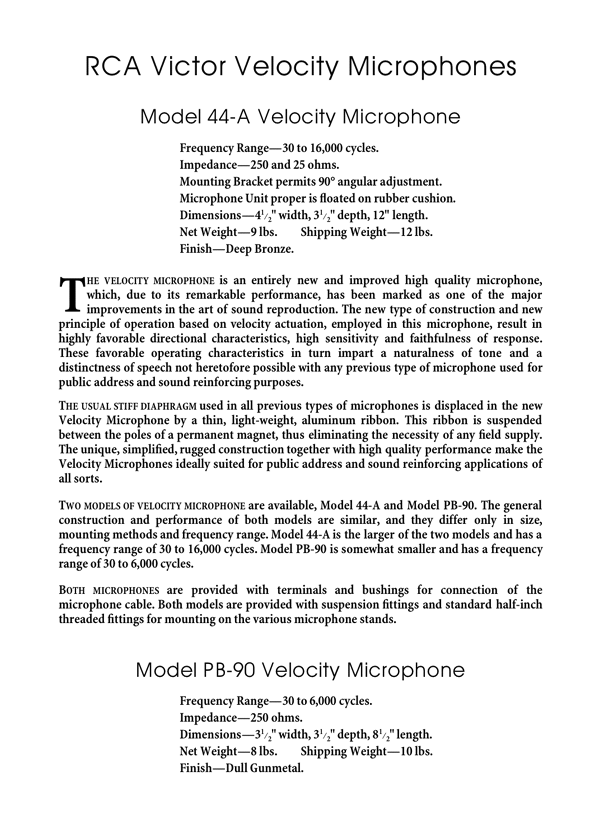
A replica of the original announcement sheet.
The Model PB-90 is presented on the next page.
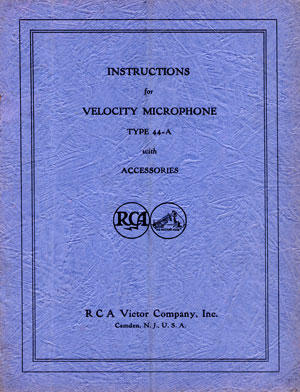
The RCA Type 44-B Velocity Mic


Introduction
The velocity microphone is the result of several years of intensive research and development toward the improvement of the characteristics of microphones as used for broadcasting, and is entirely different in principle and construction from other microphones now in use. This microphone is admirably suited to studio pick-up, public address and sound reinforcement applications.
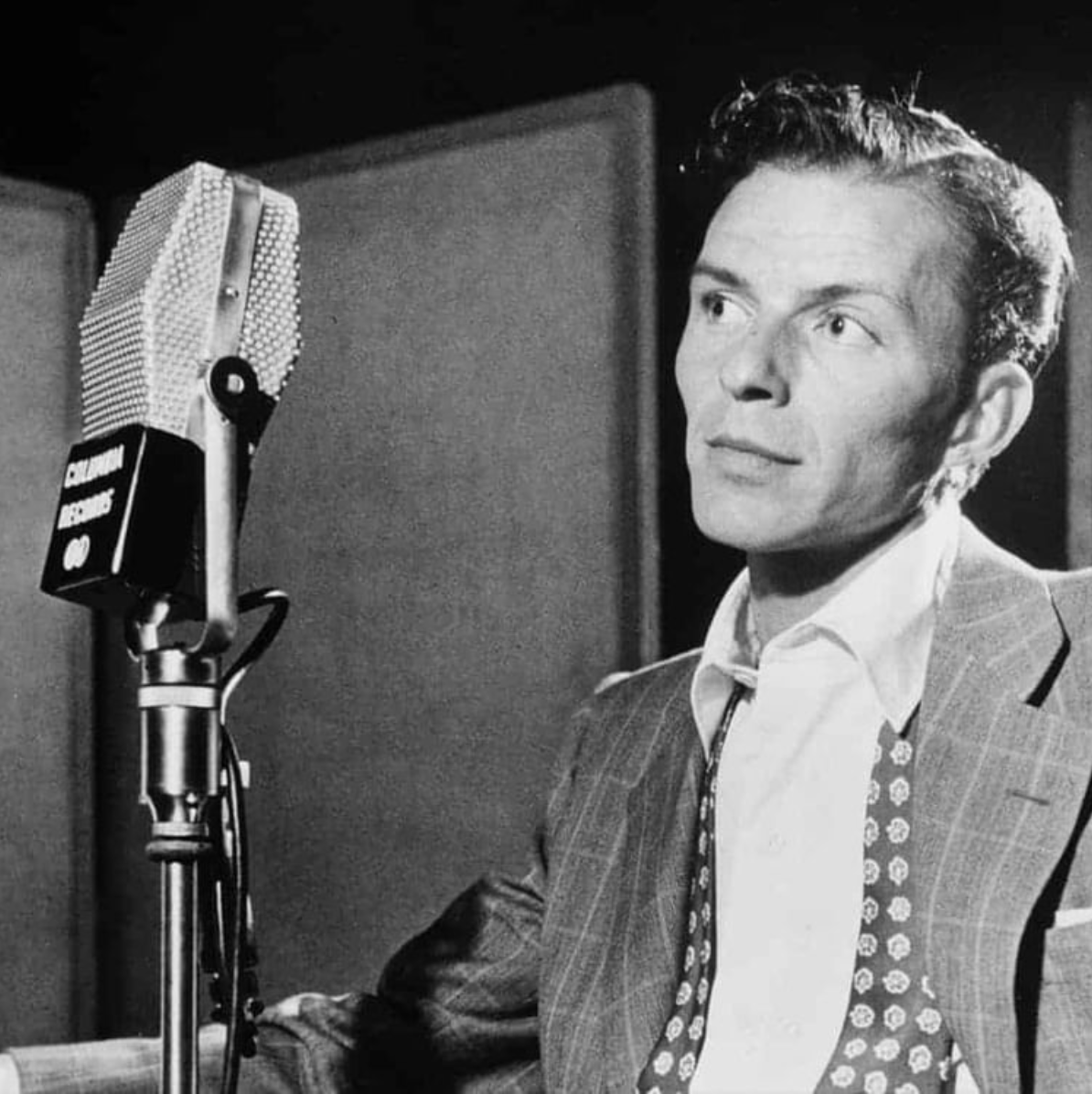
Frank Sinatra
Instead of a “diaphragm” (in the commonly accepted meaning of the word), the velocity microphone contains a thin metallic ribbon suspended between the poles of a permanent magnet with its length perpendicular to, and its width in the plane of, the magnetic lines of force. The opposite ends of the ribbon are connected to a transformer which matches the impedance of the ribbon to a 250- or 50-ohm line. Sound waves reaching the ribbon vibrate it within the magnetic field set up by the magnet. The vibration of the ribbon is in exact accordance with the sound vibrations and, occurring as it does within the magnetic field, sets up corresponding alternating electric potentials across the primary of its associated transformer. These minute voltages are subsequently amplified to the power level required for broadcasting. The microphone amplifier may be located remotely from the microphone unit when necessary or desirable.
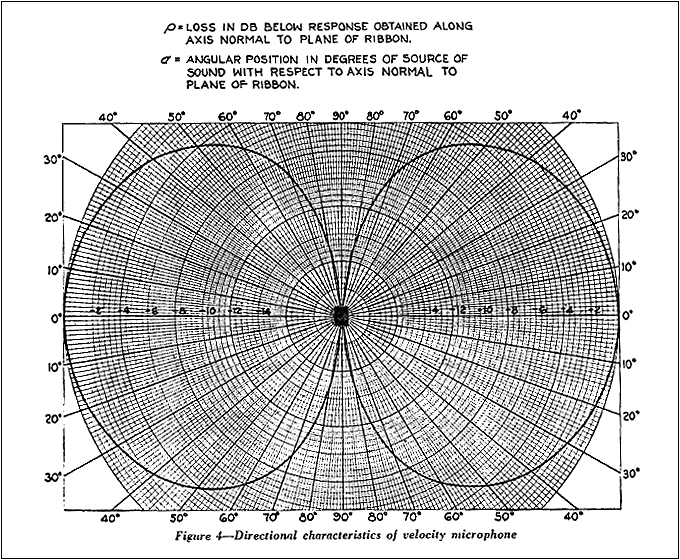
Directional Characteristics
One of the most important characteristics of the velocity microphone is its directional property. Since the ribbon is suspended in free space, sound waves approaching the microphone from a direction in the same plane as the ribbon have no effect upon it. Sound waves from either direction along an axis perpendicular to the plane of the ribbon have the maximum effect. For equal distances from the transmitter, the relative response to sound originating at various angles to the axis perpendicular to the ribbon is shown in figure 4.
It is at once apparent that this characteristic is of considerable value in the solution of some of the difficulties usually encountered in reverberant locations by the reduction of the effect of undesired sound reflections, and in the increased possibilities of obtaining better balance, clarity, naturalness, and selectivity in sound pick-up. Extraneous direct or reflected sounds approaching the microphone from side directions will have little effect, and therefore background noises and reflected sounds in the broadcast are considerably reduced, which increases, by comparison, the quality of the direct sounds reproduced. The degree of soundproofing necessary for sound originating within the “dead zone” is, of course, dependent upon the reflecting surfaces present which may return the undesired sound to the microphone from such directions that response may be obtained.
For the same allowable reverberation pick-up the operating range of the velocity microphone is approximately 1.7 times greater than a non-directional microphone having the same sensitivity. When used for public address and sound reinforcement purposes the directional characteristic is of considerable value in reducing feedback between the microphone and loudspeaker.
Sound concentrators and baffles used with condenser mics are not necessary with and inapplicable to the velocity microphone because of the fundamental difference in the principle of its operation. The transmitter must be used in free space where the flow of air particles is unimpeded. However, pick-up from the rear direction of the microphone may be eliminated by placing a baffle or shield of heavy sound absorbing material, such as heavy felt, at a distance of not less than three feet from the transmitter and so confine the pick-up to the area in front of the microphone.
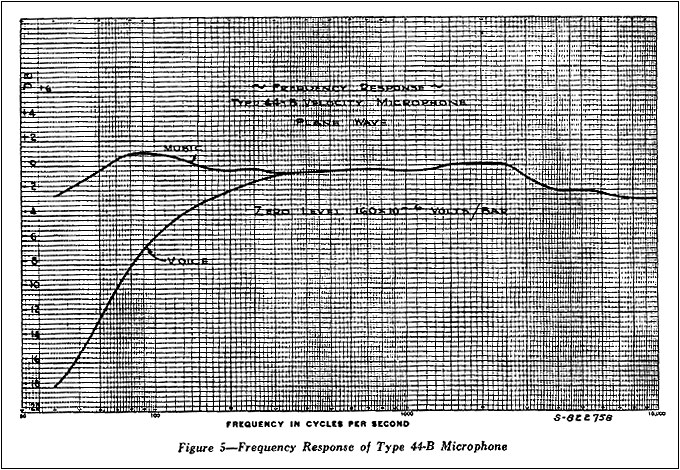
Quality of Response
The operating range of the microphone extends from 30 cycles to 15,000 cycles. When a velocity microphone is placed close to a source of sound the low frequency response is accentuated. In view of this fact, provision is made in the Type 44-B microphone to enable the user to alter its frequency response in such a manner as to suit best the particular purpose desired; viz., the pick-up of voice (i.e., within 2 feet of the microphone), or the pick-up of music (which takes place at greater distances from the microphone). Emphasis here is placed on the fact that this feature of the Type 44-B microphone is not provided with the intention that such alterations in frequency response be made at will; i.e., between selections on a broadcast program; but is furnished for the sole purpose of supplying a microphone with the best possible characteristics for vocal pick-up or for musical pick-up. It is recommended that the frequency response be adapted to either of these types of pick-up and the use of the microphone be restricted to that type of pick-up only.
A response curve taken with and without the “V” jumper is shown in figure 5. As will be observed from examination of this curve, there is a sharp decline at the low frequency end of the curve when the “V” jumper is used. It is to be noted that this curve was taken in a plane wave field, and that the curve is flat when the speaker is located at a distance of 1 foot from the microphone.
To alter the frequency response, proceed as follows: A small circular hole will be found in the cover plate of the transformer casing. Through this hole will be visible the letter “V” (voice) or the letter “M” (music), depending on whether the microphone is at the time adapted for vocal pick-up or for musical pick-up. Vocal pick-up requires the use of a jumper (upon which appears the letter “V”), which is to be placed across the two terminals marked “M” (music), located on the terminal block within the transformer housing. Access to this terminal block is obtained by removing the cover plate of the transformer housing. When the jumper “V” is used, it connects a reactor in parallel with a part of the transformer winding (when the 250-ohm connections are used), or with all the transformer winding (when the 50-ohm output connections are used). See the schematic diagram, figure 6.
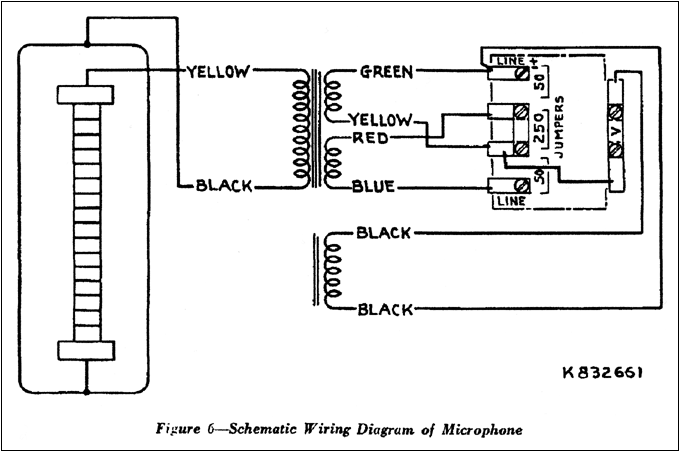
Quoted from Operating Instructions for Velocity Microphone Type 44-B (MI-4026A), 1938.
Download the 44-B specifications as a PDF.
|